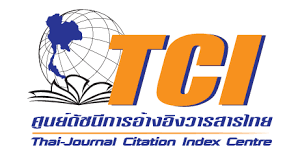A STRUCTURAL EQUATION MODEL OF SUCCESS FACTORS FOR OUTSTANDING COMMUNITY ENTERPRISES IN THAILAND
Keywords:
the causal model, operating factors, success, outstanding community enterprisesAbstract
The purposes of this research were to 1) develop the causal factors affect on the success of outstanding community enterprises in Thailand, 2) analyze direct, indirect, and total effects of the factors affecting the success of outstanding community enterprises in Thailand. The research samples were 249 community enterprises that received the Outstanding Community Enterprise Award in Thailand. Data were collected through questionnaires and subsequently analyzed using structural equation modeling. The analysis revealed a good fit between the developed causal relationship model and the empirical data (x2=87.356, df =67, x2/df =1.321, CFI=0.990, IFI=0.990, GFI=0.923, RMSEA=0.035). Leadership and innovation capabilities factors explained 84% of the variance in success variables for outstanding community enterprises. Notably, innovative capabilities exerted the strongest combined influence on operational success, with a path coefficient of 0.59. This finding suggests that leadership and innovation capabilities are critical factors influencing the success of community enterprise operations. Particularly, leaders who exhibit entrepreneurial qualities, focus on change, and possess strategic flexibility in knowledge management will enhance the group's ability to adapt to changing environments. This continuous creation of new innovations is crucial for the operational success of outstanding community enterprises.
References
กองส่งเสริมวิสาหกิจชุมชน กรมส่งเสริมการเกษตร. (2566). ผลการประกวดวิสาหกิจชุมชนดีเด่น 2566. สืบค้นเมื่อ 25 กุมภาพันธ์ 2566, จาก http://www.sceb.doae.go.th/
Addin, N. A. H. T. (2020). The relationship between the leadership and organizational performance a review. International Journal of Innovations in Engineering Research and Technology, 7(11), 120-128.
Al-Sharif, A. M., Ali, M. H., Jaharuddin, N. S., Abdulsamad, A., & Jandab, A. (2023). The role of innovation capability in the relationship between entrepreneurial leadership and innovation performance in the SMEs service industry. Advances in Social Sciences Research Journal, 10(1), 264-278. https://doi.org/10.14738/assrj.101.13802
Amabile, T. M., Barsade, S. G., Mueller, J. S., & Staw, B. M. (2005). Affect and creativity at work. Administrative science quarterly, 50(3), 367-403. https://doi.org/10.2189/asqu.2005.50.3.367
Avolio, B. J., Walumbwa, F. O., & Weber, T. J. (2009). Leadership: Current theories, research, and future directions. Annual review of psychology, 60(1), 421-449. https://doi.org/10.1146/annurev.psych.60.110707.163621
Azizah, S., Nurhayati, S., Anggraeni, A., & Helmy, I. (2021). The impact of transformational leadership on innovative capability: Mediating role of employee optimism. Management Science Letters, 11(2), 435-440. https://doi.org/10.5267/j.msl.2020.9.025
Bagheri, A., & Pihie, Z. A. L. (2011). Entrepreneurial leadership: Towards a model for learning and development. Human Resource Development International, 14(4), 447-463. https://doi.org/10.1080/13678868.2011.601594
Barney, J. B. (2014). Revisiting the resource-based view of the firm. Strategic Management Journal, 35(12), 1456-1476.
Baruch, Y., & Holtom, B. C. (2008). Survey response rate levels and trends in organizational research. Human Relations, 61(8), 1139-1160. https://doi.org/10.1177/0018726708094863
Chesbrough, H., & Bogers, M. (2014). Explicating open innovation: Clarifying an emerging paradigm for understanding innovation. Research Policy, 44(1), 1-23.
Dillman, D. A., Smyth, J. D., & Christian, L. M. (2014). Internet, phone, mail, and mixed mode surveys: The tailored design method (4th ed.). New Jersey: John Wiley & Sons.
Donate, M. J., & de Pablo, J. D. S. (2015). The role of knowledge-oriented leadership in knowledge management practices and innovation. Journal of business research, 68(2), 360-370. https://doi.org/10.1016/j.jbusres.2014.06.022
Ghasabeh, M. S., Soosay, C., & Reaiche, C. (2015). The emerging role of transformational leadership. The Journal of Developing Areas, 49(6), 459-467. https://doi.org/10.1353/jda.2015.0090
Gumusluoğlu, L., & Ilsev, A. (2009). Transformational leadership and organizational innovation: The roles of internal and external support for innovation. Journal of Product Innovation Management, 26(3), 264-277. https://doi.org/10.1111/j.1540-5885.2009.00657.x
Hair, J. F., Black, W. C., Babin, B. J., & Anderson, R. E. (2020). Multivariate Data Analysis (8th ed.). Cengage Learning.
Hair, Jr.J.F., Babin, B.J., & Anderson, R.E. (2010). Multivariate Data Analysis: A Global Perspective (7th ed.). New Jersey: Pearson Prentice Hall.
Kline, R. B. (2011). Principles and practice of structural equation modeling (3rd ed.). New York: Guilford Press.
Kline, R. B. (2016). Principles and Practice of Structural Equation Modeling (4th ed.). Guilford Press.
Meraku, A. (2017). Role of leadership in organizational effectiveness. Journal of Economics, Business and Management, 5(11), 336-340. https://doi.org/10.18178/joebm.2017.5.11.535
Mittal, S., & Dhar, R. L. (2015). Transformational leadership and employee creativity: mediating role of creative self-efficacy and moderating role of knowledge sharing. Management decision, 53(5), 894-910. https://doi.org/10.1108/MD-07-2014-0464
Naranjo-Valencia, J. C., Jiménez-Jiménez, D., & Sanz-Valle, R. (2016). Studying the links between organizational culture, innovation, and performance in Spanish companies. Revista latinoamericana de psicología, 48(1), 30-41. https://doi.org/10.1016/j.rlp.2015.09.009
Pourkarimi, J., Homayeni Demirchi, A., Fakoor, R., & Najafpour, Y. (2020). An investigation of the mediating effect of organizational creativity on the relationship between transformational leadership and organizational innov. Journal of Research in Human Resources Management, 12(3), 153-182.
Renko, M., El Tarabishy, A., Carsrud, A. L., & Brännback, M. (2015). Understanding and measuring entrepreneurial leadership style. Journal of small business Management, 53(1), 54-74. https://doi.org/10.1111/jsbm.12086
Riza, M. F., Nimran, U., Al Musadieq, M., & Utami, H. N. (2020). The Effect of Innovative Leadership and Creative Leadership to Organizational Learning, Organizational Adaptation and Adaptive Performance. JPAS (Journal of Public Administration Studies), 5(2), 51-55. https://doi.org/10.21776/ub.jpas.2020.005.02.2
Rural Development Policy Institute. (2018). Measuring the success of rural enterprises: A comprehensive approach. Journal of Rural Development, 34(2), 123-145.
Tidd, J., & Bessant, J. (2014). Innovation and entrepreneurship (2nd ed.). John Wiley & Sons.
Turner, R. C., & Carlson, L. (2003). Indexes of item-objective congruence for multidimensional items. International journal of testing, 3(2), 163-171. https://doi.org/10.1207/S15327574IJT0302_5
Uusiautti, S. (2015). Success at work requires successful leaders? The elements of successful leadership according to leaders and employees in a Finnish mid-size enterprise. International Journal of Research Studies in Psychology, 4(3), 49-65. https://doi.org/10.5861/ijrsp.2015.1164
Vasilescu, M. (2019). Leadership styles and theories in an effective management activity. Annals-Economy Series, 4, 47-52.
Yoshida, D. T., Sendjaya, S., Hirst, G., & Cooper, B. (2014). Does servant leadership foster creativity and innovation? A multi-level mediation study of identification and prototypicality. Journal of Business Research, 67(7), 1395-1404. https://doi.org/10.1016/j.jbusres.2013.08.013
Zhang, W., & Swanson, L. (2014). Community enterprises: Success factors and performance outcomes. Journal of Community Development, 39(1), 76-90.
Zhou, K. Z., & Wu, F. (2010). Technological capability, strategic flexibility, and product innovation. Strategic management journal, 31(5), 547-561. https://doi.org/10.1002/smj.830






